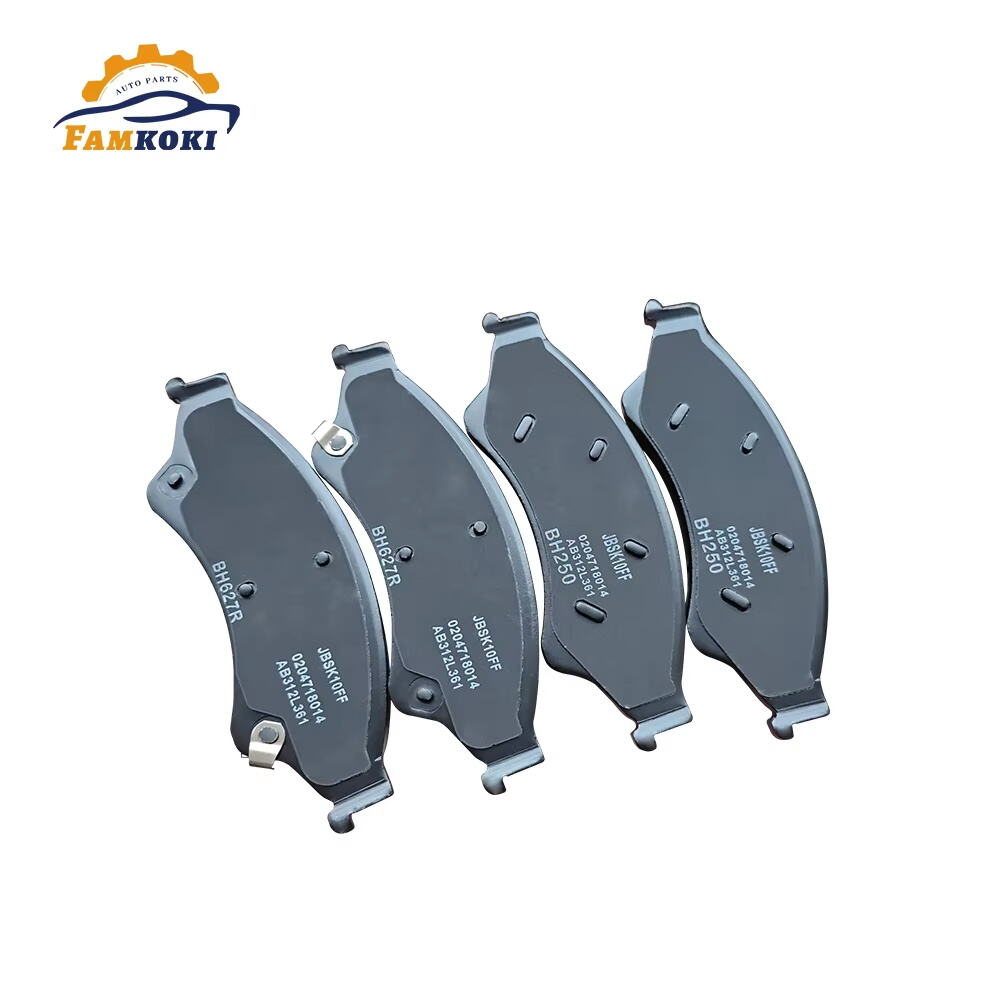Introduction - Importance of a Well-Maintained Braking System for Road Safety
A well-functioning braking system plays a pivotal role in ensuring vehicle safety, with statistics indicating that brake-related issues contribute to nearly 40% of all vehicle accidents. Proper brake maintenance is therefore crucial in preventing collisions and ensuring road safety. According to road safety organizations, there is a proven correlation between regular brake checks and a reduced incidence of accidents. By investing in routine inspections and using high-quality auto brake parts, you can significantly enhance overall driving safety. Regular maintenance not only helps in early detection of potential brake failures but also ensures that your vehicle performs optimally, safeguarding passengers and other road users.
Essential Brake Components Every Driver Should Know
To ensure maximum safety while driving, every driver should have an understanding of the essential brake components in their vehicle. These components work harmoniously to ensure effective braking, reducing the risk of accidents caused by brake failure or inefficiency. By knowing these parts, drivers can make informed decisions about maintenance and replacement to maintain road safety.
Brake Pads: The Friction Powerhouse
Brake pads play a pivotal role in a vehicle's braking system by creating friction against the rotors to facilitate effective stopping. This friction is crucial for decelerating or stopping the vehicle. Various types of brake pads, such as organic, semi-metallic, and ceramic, serve different applications and preferences; for instance, ceramic pads offer superior performance and longevity but at a higher cost. Regularly checking and replacing brake pads is essential because worn-out pads not only reduce stopping power but also increase the risk of overheating, which can lead to brake failure. According to studies, neglected brake pads contribute significantly to wear rates and failures.
Rotors: Discs That Handle the Heat
Rotors are key components of the braking system, responsible for dissipating the heat generated during braking to prevent brake fade, which is a reduction in stopping power typically caused by overheating. There are different types of rotors available, such as vented, slotted, and drilled, each offering distinct advantages such as improved cooling and debris removal. It is crucial to consider rotor resurfacing and replacement in maintenance schedules, as advised by automotive experts, to ensure consistent brake efficiency. Properly maintained rotors guarantee that the system can handle repeated stopping demands without a loss of performance.
Calipers: Applying Pressure for Stopping Power
Brake calipers are essential in the braking system, applying pressure on the brake pads to clamp them against the rotors, thereby inducing the friction necessary for stopping. There are two main types of calipers: fixed and floating. Fixed calipers provide balanced pressure, are more durable, and tend to be used in high-performance settings, while floating calipers are lighter and less expensive. Statistics show that caliper failure rates can significantly impact braking reliability and safety, making regular inspections imperative to prevent potential failures that may lead to serious safety concerns.
Brake Lines and Fluid: The Hydraulic Lifeline
Brake lines and fluid are vital components enabling the hydraulic system's operation, transferring pressure from the brake pedal to the calipers. The correct choice of brake fluid is crucial, with DOT3, DOT4, and DOT5 fluids varying in boiling points and applications. Brake line issues, such as leaks or corrosion, can lead to brake failure, evident through symptoms like a spongy pedal or fluid leaks. Hydraulic integrity ensures safe braking performance, highlighting the importance of regular inspections and timely replacements.
Master Cylinder: Controlling the Braking Force
The master cylinder converts pedal pressure into hydraulic pressure, powering the brake system's operation. This component is essential for delivering the force needed for effective braking. Regular maintenance of the master cylinder is crucial to prevent performance issues, as malfunctions can lead to inadequate braking force and compromised safety. According to accident reports, faulty master cylinders contribute significantly to collisions resulting from brake system failures. Understanding the symptoms of a faulty master cylinder ensures prompt interventions, safeguarding overall driving safety.
How to Choose the Right Auto Brake Parts
Material Matters: Ceramic, Semi-Metallic, and Organic Pads
When selecting brake pads, the materials used significantly influence performance and suitability to driving conditions. Here, we'll examine the three major types: ceramic, semi-metallic, and organic pads.
- Ceramic Brake Pads: Known for being lightweight and producing less noise and dust, ceramic pads offer smooth braking and are ideal for everyday city driving. They have a long lifespan but can be costlier and less effective in extreme heat compared to other types.
- Semi-Metallic Pads: Composed of metal fibers and are renowned for their durability and excellent heat dissipation. They are suitable for heavy-duty applications or performance vehicles but tend to be noisier and may wear rotors faster.
- Organic Pads: Made from materials like rubber, carbon, and Kevlar, they provide quiet operation and are cost-effective. However, they tend to wear out quicker and may not perform as well in high-stress situations.
Experts recommend choosing brake pad materials based on driving habits. For instance, a city driver might prefer ceramic pads for their low noise, while a driver tackling rugged terrain may benefit from semi-metallic pads for their resilience.
Performance Needs: Daily Driving vs. Heavy-Duty Use
Different driving styles demand distinct brake components to ensure safety and performance. For typical daily driving, brake parts that offer smooth operation and longevity, such as ceramic pads, might suffice. They provide a balance between performance and comfort, ideal for common city or highway routes.
In contrast, heavy-duty or high-performance driving can significantly strain brake systems. Such conditions often require robust components, like drilled and slotted rotors paired with semi-metallic pads, to handle the increased heat and stress. These setups are better suited for spirited driving or towing, ensuring effective heat dissipation and stopping power under pressure.
Automotive research indicates that mismatched brake components lead to increased wear and performance issues. Therefore, understanding your vehicle's demands and your driving patterns is key. For everyday use, focus on longevity and comfort, whereas for heavy-duty applications, prioritize heat management and durability. Making an informed choice not only enhances vehicle performance but also ensures safety on the road.
Warning Signs Your Brake Parts Need Replacement
Squealing or Grinding Noises
Squealing or grinding noises from your vehicle's brakes are often the first signs that something isn't right. These sounds usually indicate that the brake pads have worn down so much that the metal components are now contacting the rotors. This situation demands immediate attention, as continuing to drive could lead to further damage. According to automotive experts, ignoring these signs could cause rotor damage and result in costly repairs. Statistics show that 70% of brake-related complaints involve noise, underscoring its importance as an early indicator of brake wear. If you hear these noises, schedule an inspection promptly to ensure your brake components are in proper condition.
Vibrations During Braking
Experiencing vibrations or pulsations in the brake pedal can point to significant issues with your braking system, typically indicating warped rotors or uneven wear. Neglecting this problem can lead to severe damage over time, potentially compromising your vehicle's safety. Automotive analysts warn that vibrations during braking not only increase brake wear but also pose significant safety hazards if left unresolved. Experts recommend addressing such vibrations immediately to maintain effective braking performance and prevent accidents. Regular inspections and maintenance can help identify and rectify these issues early, ensuring the longevity of your brake parts.
Longer Stopping Distances
An increase in stopping distances is a clear sign that your brake system needs attention. This issue often indicates failing brake components, which can drastically affect your vehicle's performance and road safety. According to road safety studies, inefficient brakes are a major contributor to accidents due to longer stopping times. Regular maintenance plays a critical role in ensuring optimal stopping power and avoiding mishaps. Experts emphasize that routine checks and timely replacements are crucial to maintaining your brakes' efficiency and ensuring safety on the road. Ignoring these signs could lead to more severe performance issues.
Conclusion - Ensuring Smooth and Safe Stops with Quality Brake Parts
Understanding brake components and regular maintenance is essential for road safety. Proper upkeep of your vehicle's braking system not only ensures smooth and reliable stops but also contributes significantly to prolonging the lifespan of your vehicle. Brake maintenance, including regular inspection and immediate attention to warning signs, helps in averting potential accidents and enhances overall system performance. For a comprehensive guide to maintaining your brake parts effectively, consider engaging with resources or services dedicated to automotive care. Prioritize your road safety with diligent brake system checks and timely replacements.
FAQ
Why is regular brake maintenance important?
Regular brake maintenance is crucial for early detection of potential failures and to ensure optimal performance, reducing the risk of accidents.
What are the main components of a braking system?
The main components include brake pads, rotors, calipers, brake lines, fluid, and the master cylinder.
How do I choose between OEM and aftermarket brake parts?
Consider your vehicle's needs, driving conditions, and budget. OEM parts offer guaranteed quality and fit, while aftermarket parts provide broader options and might be more cost-effective.
What material should I choose for brake pads?
Choose based on driving habits. Ceramic pads are ideal for quieter, everyday driving, while semi-metallic pads are better for heavy-duty applications.
What are the warning signs of failing brake parts?
Warning signs include squealing noises, vibrations during braking, longer stopping distances, and dashboard warning lights.
 EN
EN
 AR
AR
 FR
FR
 KO
KO
 PT
PT
 RU
RU
 ES
ES


